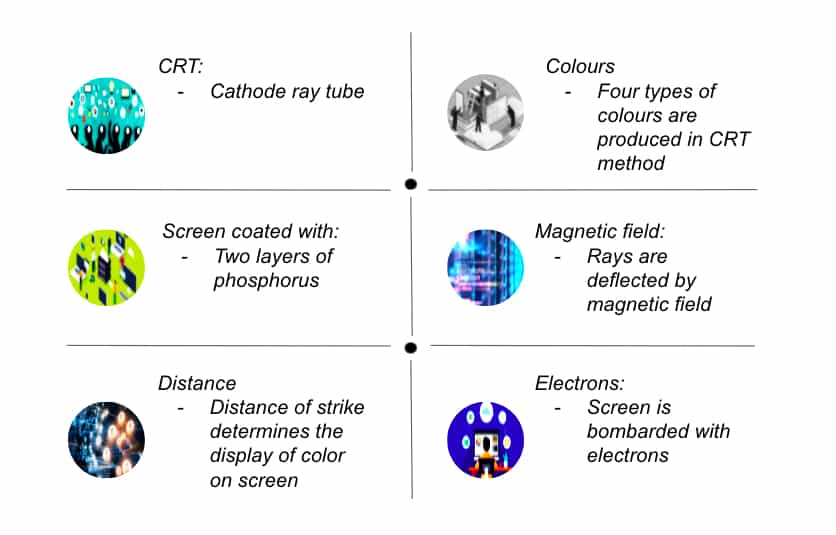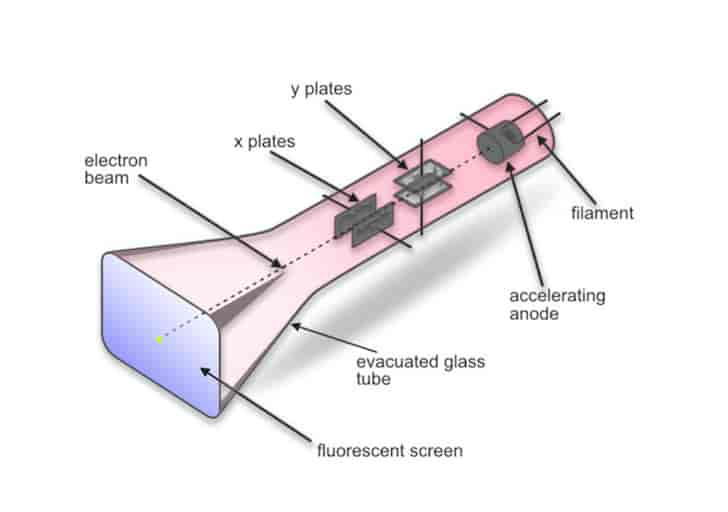
Table of Contents
Introduction
This article is about “Beam Penetration Method”, hope you will like the information. If yes please do share it with others.
CRT or cathode ray tube monitors display images on screen by using combination of different colours of phosphorous, which when bombarded with electrons of different velocity and distance creates different colours.

Beam penetration method is usually used in televisions, although new technology has also came into it with time.
To give a better understanding on the topic some multiple choice questions (MCQs) are also provided below on beam penetration method.
Que (1). What is the full form of CTR?
Ans (A). 3. Cathode Ray Tube
The following video explains about cathode ray tube experiment very well with the help of beam penetration method diagram, do refer this for visualisation instead of simple rote learning.
Further reads:
- Cathode-ray tube
- Cathode ray tube – Comparison with other technologies
- Comparison of CRT, LCD, plasma, and OLED displays
- Components of Cathode Ray Tube
In Beam Penetration method:
In cathode ray tube (CRT) method the screen is coated with two layers of phosphorous i.e. red and green.
Que (2). In CRT method screen is coated with:
- Iron
- Sodium
- Radium
- Phosphorous
Ans. Phosphorous
Further reads:
- Phosphors for Cathode-Ray Tubes (CRTs)
- Color CRT Monitors
- Difference between Beam Penetration and Shadow Mask
- Refresh type output devices in Computer Graphics
- Advantage beam penetration has been an inexpensive
Que (3). In CRT method screen is coated with how many layers of phosphorous?
- 2
- 3
- 4
- 1
Ans. 2 i.e. screen is coated with 2 layers of phosphorous
Que (4). In cathode ray tube experiment display of colour on screen depends on?
- Distance
- Displacement
- Angle of strike
- All of the above
Ans. 1. Distance
In cathode ray tube experiment the display of colour on screen depends on distance from which the electrons are penetrating the phosphorous layer present on screen.
Que (5). What are the different types of colour produced in cathode ray tube method?
- One
- Two
- Three
- Four
Ans. 4. Four
In cathode ray tube method basically 4 types of colours are produced i.e. red, green, orange and yellow (this is one of the disadvantage as well as only 4 colours are possible).
Another disadvantage of this method is that the quality of picture is not very good. But, it’s quite inexpensive.
Further Read:
Que (6). Cathode rays are deflected by:
- Light
- Vaccum
- Magnetic field
- All of the Above
Ans. 3. Magnetic field
Cathode ray although gets affected by magnetic field i.e. applying magnetic field around it changes it’s normal course and it gets deflected which otherwise travels in a straight line.
Further Read:
- Cathode rays are deflected by
- Why cathode rays are deflected by magnetic field?
- In which direction cathode rays deflect in the presence of magnetic field?
Que (7). In cathode ray tube screen is bombarded with:
- Protons
- Neutrons
- Electrons
- Mixture of all
Ans. 3. Electrons
Same, phenomenon happens in case of TV as well which user cathode ray tubes in them. Screen when bombarded by electrons produces different colours.
- Beam penetration method ppt link: refer this link for sample presentation on beam penetration method although it’s quite basic with only 13 pages.
- Beam penetration method in computer graphics in hindi: Although we have tried our best to provide explanation in english with the help of MCQs, but for hindi readers we are adding a hindi article link as well, which is explaining the CRT method with the help of diagrams what it is and how it works, colours produced etc.
- In beam penetration method of colour crt there are two layers of phosphorus red and green coated inside the screen, and the colour shown depends on from how far the electron beam is penetrating the phosphorus surface.
So, this is all about “Beam Penetration Method”, do let us know in comment section what else you want to read about or some other information you require in the current topic i.e. “How to freeze a row in google sheets”, we are more than happy to help you.
Source: Click me
2 thoughts on “MCQs – Beam Penetration Method”